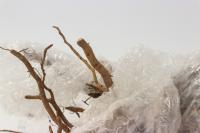1、 Curing method
1. Temperature: Clematis needs to provide a warm environment for its normal growth, because its cold resistance is not very high, so the normal growth temperature is between 25 ℃ and 30 ℃, and it is not allowed to move outdoors in winter. The minimum ambient temperature should be kept above 15 ℃, otherwise it will stop growing or be easily frostbitten

2. Watering: Clematis likes wet soil, but there should be no ponding in the process of watering. Flooding will lead to plant root ulceration. Ventilation should be maintained after watering, which can reduce the breeding of bacteria and avoid the occurrence of diseases and pests, so watering should be thorough

3. Light: it has certain shade resistance, so strong light must be avoided in summer. It cannot be directly placed on the balcony. Shade must be done in place, otherwise the branches and leaves of the plant will turn yellow. But in order to ensure normal flowering, we also need to accept warm sunshine

4. Fertilization: fertile soil will promote its branches and make its rhizomes grow more ideal, so it can be properly fertilized during growth, mainly with compound fertilizer, but nitrogen fertilizer can be reduced during flowering

2、 Breeding skills
1. Propagation: sowing and cutting are two main propagation methods. Sowing is carried out in September of each year, which can be collected and sown at the same time, so that the survival rate will be higher. It can also be carried out in spring. After sowing, pay attention to temperature and watering, and wait for germination. Cutting is suitable for spring. Select the branches of the current year and cut directly. However, compared with the two methods, seed reproduction can be planted in a large area

2. Pruning: in order to promote the growth of roots, flower buds and lateral branches can be properly pruned. In addition, cutting off the internal branches and leaves can increase the light transmittance

3、 Diagnosis and treatment problems
1. Disease: ponding will lead to rotten roots, so ventilation must be maintained after watering to avoid water flooding the roots and rotting them

2. Insect pest: the occurrence of insect pest is very small. Usually, pay more attention not to be too muggy, so there will be no insect pest

4、 Other issues
1. Toxicity: there is no poison. It can be used as medicine and can be cultured in a large area

2. Whether it can be raised at home: Yes, it has been used as medicine


 jackfruit
jackfruit snake plant
snake plant hibiscus
hibiscus hydrangea
hydrangea lavender
lavender Green roses climb al...
Green roses climb al... If you don't pay att...
If you don't pay att... Management of four g...
Management of four g...

































